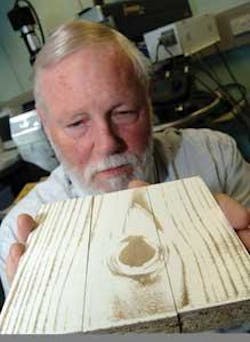Medium-density fiberboard, or MDF, is probably one of the most versatile and useful wood products. It is much cheaper and environmentally friendlier than using virgin wood and has found application everywhere that it can, subject to one constraint: it’s not very pretty to look at.
That deficiency looks set to change, thanks to efforts by Ken Young and Peter Hancocks at Warwick University (Warwick, England). The researchers, in a collaboration with six furniture and wood industry partners, have developed a new technique to imprint dazzling wood grains onto MDF, livening up its appearance.
The LaserCoat project uses a CO2 laser and computer-driven three-mirror scanner to selectively etch the MDF surface. In a more flexible approach, laser-cured electrostatic powder coatings are used to achieve the effect, with the laser selectively curing the powder in patterns that can be loaded into the system as simple image files.
The coating process is an integration of industry standards for a novel application. “Electrostatically applied powder coating is widely used in the furniture industry because it is solvent-free and equipment is relatively low cost,” says Peter Hancocks. “However, it can only produce a covering as opposed to a pattern. Laser sintering of powders is an established application and it was hoped that it would prove possible to selectively cure powder coat into patterns, initially on flat surfaces but ultimately onto real profiles.”
Getting the conditions right is no simple task, though. The coating process, Hancocks says, “depends upon some moisture content in the MDF for the electrostatic coating process to work. This moisture can be problematic when curing the powder as it can cause bubbling through the paint film so careful choice of conditions and parameters is required.”
The etching process, while technologically more straightforward, is limited to one color, with its brightness controlled precisely with the incident laser power. “Coating offers the prospect of multiple colors and almost unlimited color choice, and is expected to have its share of applications,” Hancocks says
The collaboration, funded in part by the U.K. government’s Department for Business, Enterprise, and Regulatory Reform, is now in its final year. Hancocks says the group is working to scale up the process in a commercially viable way, incorporating either higher-power lasers to increase production rates, or the use of commercially available “plotter” CO2 systems.
